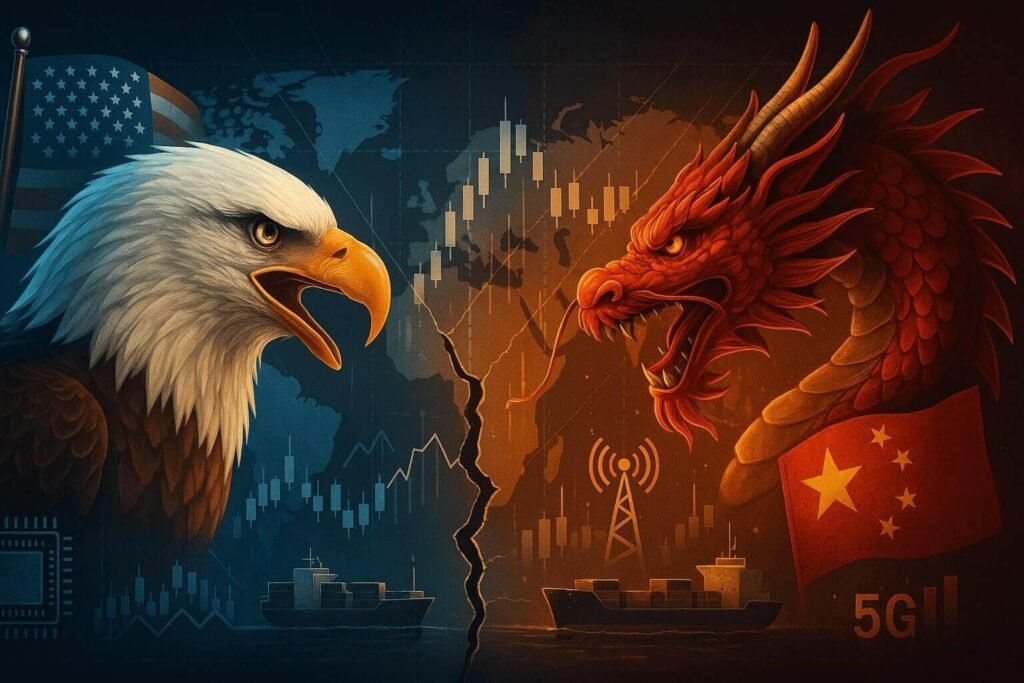
The economic relationship between the world’s two largest powers has descended into unprecedented territory. What began as targeted tariffs during the first Trump administration has escalated into a full-scale economic confrontation, with far-reaching implications for global markets, supply chains, and geopolitical alliances. As America and China exchange increasingly punitive tariffs—now reaching a staggering 145% on the US side and 125% on the Chinese side—we are witnessing nothing short of a historic economic decoupling.
This comprehensive analysis examines the causes, current dynamics, and strategic implications of the US-China economic war. Beyond the headlines and political rhetoric, we explore which sectors, countries, and companies stand to benefit from this reshuffling of global trade patterns, and which face existential challenges.
The Escalation to Economic Warfare
The US-China trade relationship, once heralded as the backbone of global economic growth, has unraveled with startling speed. While tensions have simmered since 2018, the current escalation began in early 2025 when President Trump cited Chinese fentanyl exports as a pretext for imposing a 10% tariff on Chinese goods. What followed was a rapid spiral of retaliations:
- February 2025: Trump imposed initial 10% tariffs on Chinese imports, citing fentanyl concerns
- March 2025: Tariffs increased to 20% as China retaliated with targeted measures on US agricultural products
- April 2025: US imposed “reciprocal tariffs” bringing the total to 54%, followed by Chinese matching tariffs
- April 7-11, 2025: A dramatic escalation occurred, with US tariffs ultimately rising to 145% and Chinese retaliatory tariffs reaching 125%
This is no longer a targeted trade dispute—it represents a fundamental restructuring of the world’s most important bilateral economic relationship. China has now effectively declared that further escalation would be meaningless, stating it would “become a joke in the history of world economy” if tariffs continued to rise.
Beyond Political Posturing: The Structural Causes
While political rhetoric often dominates headlines, the roots of this conflict lie in profound structural imbalances:
The Persistent Trade Deficit
The US-China goods trade deficit has expanded dramatically since China joined the WTO in 2001, reaching a peak of $418 billion in 2018. Despite previous tariff measures, it remained stubbornly high at $295 billion in 2024. This persistent imbalance reflects fundamental differences between the two economies:
- Savings Rate Disparity: Chinese households save more than 30% of disposable income on average, compared to just 7% in the United States
- Industrial Policy: China’s state-directed economic model provides significant subsidies to strategic industries
- Currency Management: Historical accusations of currency manipulation, though less prominent in recent years
Technology and National Security Concerns
Beyond trade balances, the conflict increasingly centers on technological competition and national security:
- Intellectual Property: US claims of Chinese IP theft costing $225-600 billion annually
- Forced Technology Transfer: Allegations that China requires foreign companies to transfer technology as a condition of market access
- Strategic Industries: Growing competition in critical sectors such as semiconductors, artificial intelligence, and clean energy technology
- Military Applications: Concerns about dual-use technologies with national security implications
Sector-Specific Impacts: Where the Battle Lines Are Drawn
The trade war’s impact varies dramatically across economic sectors. Understanding these differences reveals both the strategic calculus behind tariff policies and the opportunities emerging in this restructured economic landscape.
Agricultural Markets: The Soybean Battlefield
Soybeans have emerged as a critical flashpoint in the trade dispute for several strategic reasons:
- US farmers export approximately 50% of their soybean production
- China has historically been the largest single purchaser of US soybeans
- Soybean farmers represent a politically significant constituency
The targeting of US soybean exports by China has created both losers and winners:
Losers:
- US soybean farmers faced an estimated $9.4 billion in export losses during previous trade tensions
- Farm bankruptcies increased, with soybean farmers accounting for a disproportionate share
- Acreage planted with soybeans decreased by 15% as farmers shifted to other crops
Winners:
- Brazil has emerged as China’s primary soybean supplier, with exports to China rising substantially
- Argentina has increased soybean meal and oil exports to China
- Russia has expanded agricultural exports to China across multiple categories
The renewed trade tensions in 2025 are likely to accelerate these trends, with Brazilian farmers potentially capturing an even larger share of Chinese soybean demand.
Battery Storage: The Technology Front
The battery storage sector illustrates how the trade war intersects with technological competition and security concerns:
- China currently accounts for over 70% of US lithium-ion battery energy storage system imports
- These systems are critical for renewable energy integration and grid stability
- The technology has significant dual-use applications in defense systems
The imposition of 145% tariffs on Chinese battery imports creates several strategic dynamics:
Short-term disruption:
- US grid-scale battery storage projects face potential delays and cost increases
- Renewable energy deployment may slow temporarily
- Critical battery supply shortages could emerge in certain applications
Long-term restructuring:
- Korean, Japanese, and Taiwanese manufacturers will likely expand market share
- US domestic manufacturing capacity will accelerate development
- New supply chains will emerge focused on “friendshoring” with US allies
This reshuffling of the battery supply chain reflects a broader pattern of economic realignment that extends well beyond this single industry.
Electronics and Consumer Technology: Selective Targeting
In a notable strategic decision, the US has excluded certain consumer electronics from the highest tariff levels, including:
- Cellphones
- Personal computers
- Other consumer electronics
This selective approach reveals a careful balancing act: disrupting Chinese industrial policy while attempting to shield American consumers from the most visible price increases. Nevertheless, the broader technological decoupling continues to accelerate.
Critical Minerals: China’s Strategic Leverage
In response to US tariffs, China has weaponized its dominant position in critical mineral supply chains:
- Restricted exports of rare earth elements used in everything from electronics to military systems
- Limited access to processed minerals needed for electric vehicle batteries
- Imposed controls on graphite needed for battery anodes
This response highlights China’s ability to target precise pressure points in complex global supply chains, especially in sectors critical to energy transition and advanced manufacturing.
Beyond US and China: Third-Country Opportunities
The economic confrontation between Washington and Beijing is creating significant ripple effects across the global economy. For many countries, the trade war presents both challenges and unexpected opportunities.
Emerging Winners: Supply Chain Relocation Beneficiaries
Several countries are emerging as beneficiaries of supply chain diversification:
Vietnam: The Primary Manufacturing Alternative
Vietnam has capitalized most effectively on manufacturing relocations from China:
- Electronics assembly has seen particularly strong growth
- Furniture, textiles, and consumer goods manufacturing has expanded
- Foreign direct investment has surged, with both US and Chinese companies establishing operations
Taiwan: The Technology Haven
Despite its complex relationship with mainland China, Taiwan has benefited significantly:
- Semiconductor manufacturing has expanded
- Companies like Quanta Computer, Sercomm, and Wistron have repatriated production
- Over 21,000 new jobs have been created
- The New Taiwan Dollar has strengthened beyond pre-trade war expectations
Mexico: The Nearshoring Option
Mexico’s strategic position as a US neighbor has created unique advantages:
- Motor vehicle manufacturing has increased
- Electronics assembly has grown
- Logistics infrastructure is expanding to handle increased trade volume
South Korea: The Strategic Balancer
South Korea has deftly navigated the tensions between its security ally (US) and largest trading partner (China):
- Electronics exports have increased
- Semiconductor production has expanded
- Battery manufacturers like LG and Samsung have secured preferential access to the US market
ASEAN: The Region in Between
The Association of Southeast Asian Nations (ASEAN) finds itself in a pivotal position:
- Regional trade integration has accelerated
- Trade re-routing and re-labeling have redirected Chinese exports through ASEAN countries
- Regional infrastructure development has increased
Europe: Strategic Autonomy Tested
The European Union faces complex strategic choices:
- Manufacturers, particularly German companies, have been caught in the crossfire
- Some sectors have benefited from trade diversion
- The EU has accelerated its own strategic autonomy initiatives in technology and supply chains
The Future Economic Landscape: Four Scenarios
As this economic confrontation unfolds, four possible scenarios emerge for the future of US-China economic relations:
Scenario 1: Continued Escalation
In this scenario, the economic decoupling deepens:
- Further expansion of tariffs to services and investment
- Comprehensive technology restrictions
- Financial decoupling including restrictions on capital flows
- Third countries forced to choose sides more explicitly
Scenario 2: Strategic Negotiated Settlement
This middle path would see selective decoupling in strategic sectors while maintaining integration in others:
- Reduced tariffs in non-strategic goods
- Continued restrictions in technology, defense, and critical minerals
- Sectoral agreements on specific issues
- Limited reversal of existing measures
Scenario 3: Regional Bloc Formation
The global economy could fragment into competing economic blocs:
- US-led bloc of allies and partners
- China-centered Asian economic sphere
- Non-aligned countries seeking to balance relations
Scenario 4: Renewed Integration
The least likely scenario would involve a substantive de-escalation:
- Mutual tariff reductions
- New institutional frameworks for managing economic competition
- Reformed global trading system
Strategic Implications for Businesses and Investors
The restructuring of US-China economic relations presents both risks and opportunities for businesses and investors globally.
Supply Chain Strategy
Companies must reconsider their global footprint:
- China+1 Strategy: Maintaining Chinese operations while developing alternative manufacturing bases
- Friendshoring: Prioritizing operations in politically aligned countries
- Regionalization: Developing separate supply chains for US, Chinese, and European markets
- Vertical Integration: Securing critical inputs through ownership or long-term contracts
Investment Positioning
Investors can find opportunities in this shifting landscape:
- Reshoring Beneficiaries: Companies involved in building domestic manufacturing capacity
- Alternative Suppliers: Non-Chinese companies in sectors facing restrictions
- Logistics Innovation: Firms adapting to new trade flows
- Trade Finance: Instruments supporting new cross-border relationships
Geopolitical Risk Management
Organizations must develop more sophisticated approaches to managing geopolitical risk:
- Scenario Planning: Preparing for multiple potential trajectories
- Political Intelligence: Improving monitoring of policy developments
- Regulatory Navigation: Understanding compliance requirements across diverging regimes
- Stakeholder Management: Addressing increasingly complex political pressures
Conclusion: Navigating the New Economic Order
The US-China economic war represents more than a temporary disruption—it signals a fundamental restructuring of the global economic architecture that has prevailed since the end of the Cold War. This shift will create both profound challenges and unexpected opportunities for countries, companies, and investors.
Those who prosper in this new environment will be those who recognize that the world is not simply deglobalizing, but rather reglobalizing along new parameters. The most successful strategies will involve neither naive hope for a return to the previous order nor simplistic retreat into isolation, but rather sophisticated navigation of a more complex, fragmented, and politically charged global economy.
The economic confrontation between the world’s two largest powers will continue to reshape markets, supply chains, and alliances for years to come. Understanding the structural forces driving this conflict, rather than focusing solely on the political personalities involved, provides the clearest map for navigating the economic terrain ahead.
This analysis represents an independent assessment based on publicly available information as of April 2025. It is intended to provide strategic perspective rather than specific investment advice.




2 Responses
The historic nature of this economic decoupling reminds me of Cold War-era shifts, but with supply chains replacing ideology as the battleground. Do you think the private sector is adapting fast enough to stay competitive in this new trade environment?
Totally agree, it really does feel like a modern version of the Cold War, but now it’s all about chips, trade routes, and who controls what. Honestly, some companies are adapting fast, especially the big tech and manufacturing giants. But a lot of others are still playing catch-up. It’s a whole new game and the rules keep changing.